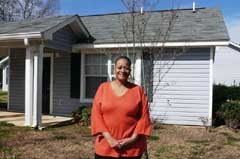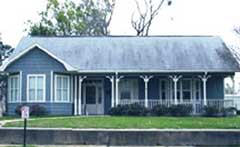 |
Home | En Español | Contact Us | A to Z |
 |
Tammy's Road to Recovery
As her Lupus progressed, work became increasingly difficult. There were days when she couldn't get out of bed from the pain. She worked for a temp agency, never knowing when her autoimmune disease would flair up and render her unable to work. Continuing to struggle with depression and alcohol, Tammy tried several treatment programs. Each time she would relapse back into depression and alcohol abuse. Time and again, her parents stepped in to help her. "God bless my parents for taking care of my children - and me" she says. "I really wanted to stop, but treatment never seemed to work for me." In September 2005 after the death of her father and another failed attempt at recovery she took a bus to Shreveport, LA. One of her daughters lived nearby and had been told of a good treatment facility there. "I was in a state of complete helplessness. I kept slipping into a cycle of deep depression and drinking. I was really afraid and remember thinking 'this is going to be my life.'" In treatment she worked with her case manager to develop a release plan. The counselor suggested she consider a program called "REACH", a transitional housing program for people diagnosed with persistent mental illness, substance abuse problems and homeless or at high risk of homelessness. A nine bed facility run by continuum of care provider Community Support Programs, REACH serves some of the most difficult to serve of the homeless population, clients diagnosed with co-occurring disorders: 1) a mental illness, and 2) substance abuse such as drug use or alcoholism. Clients progress through a two-year, individualized program with four goals: abstinence from substance abuse, mental health stability, permanent housing, and attainment of employment and financial solvency. An acronym for Recovery, Empowerment, Affirmation, Challenge and Hope, REACH encourages clients to create their own personal goals - a crucial step toward independence. "REACH was just the program that I needed" says Tammy. "It's a very structured environment staffed with people concerned with recovery. The program works to help you. From the first day, you set goals and plans. There's always someone there to talk to, and they have access to mental health counseling, medication monitoring, a relapse prevention group, things that really helped me." At REACH we learned to 'squash' problems right away." "Mrs. Pontress the house manager was wonderful. She knew when something was wrong, even if you didn't say it. They are really strict about the rules, she notes, "but all of that is for your benefit." They also teach fundamental life skills such as budgeting, "how to make a meal with what you have," personal hygiene, coping skills, how to take care of yourself. "Nobody was a slave driver" says Tammy. "They just taught us how to be self sufficient and live in a community. You have to show initiative and respect for yourself and others." "REACH was my saving grace", she says with a smile. "I'd probably be dead, in a mental hospital of last resort or homeless on the street if it weren't for REACH". The highly structured environment was difficult for some people to adjust to, "but it was what I needed," she says. "There were a few times I wanted to leave, but something about the program made me stay. I knew I was getting better." When she finished the program at REACH she was approved for an apartment in Virginia Place, a HUD Section 811 supportive housing development with fourteen one bedroom apartments. Located in the Highland neighborhood, Virginia Place apartments are permanent housing for those with chronic mental illness. Run by Community Support Programs, residents receive income based rental assistance and supportive services from case management staff. It's an attractive, well kept development, in keeping with the character of the neighborhood. "And it's close to REACH," she says. "I know the doors are always open if I need their support. It's been a wonderful program for me." Tammy loves her apartment at Virginia Place. It's a place her grandchildren can visit. She's even started going to church again and takes her granddaughters. She laughs, "I was recently baptized at 49!" With encouragement from Virginia Place staff and her daughters, she's gone back to school. She's taking college courses, some of them on-line to help her keep a schedule that isn't too physically demanding. She'll graduate later this year. - And her Lupus? It's in remission. Tammy wants to go back to work when she finishes school in a job that helps others, so she can give something back. "If I have to work from a wheelchair, that would be fine," she says. "I'm determined now; I can't let that get in my way."
|
|||||
| Content Archived: July 18, 2011 | |||||



